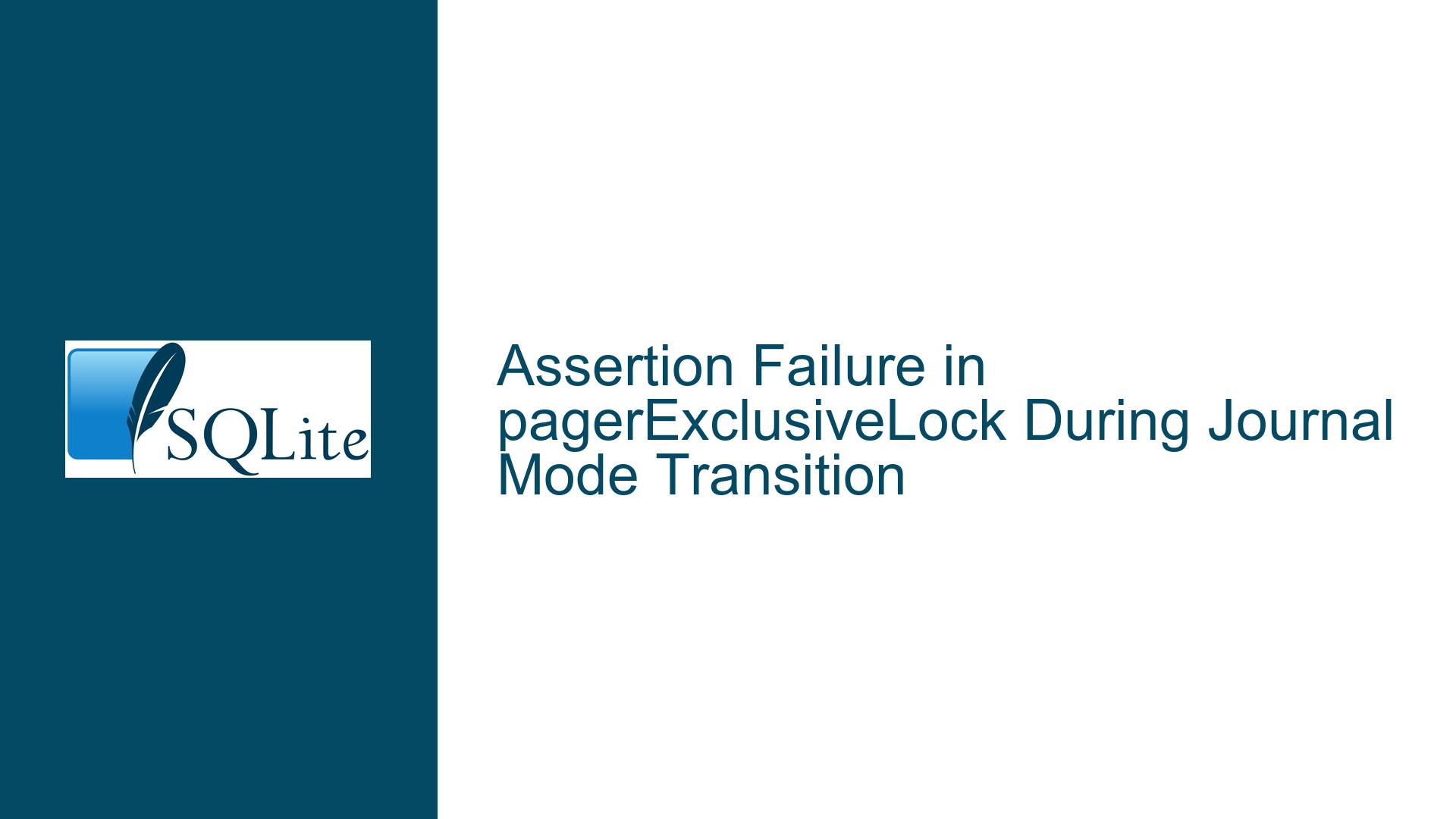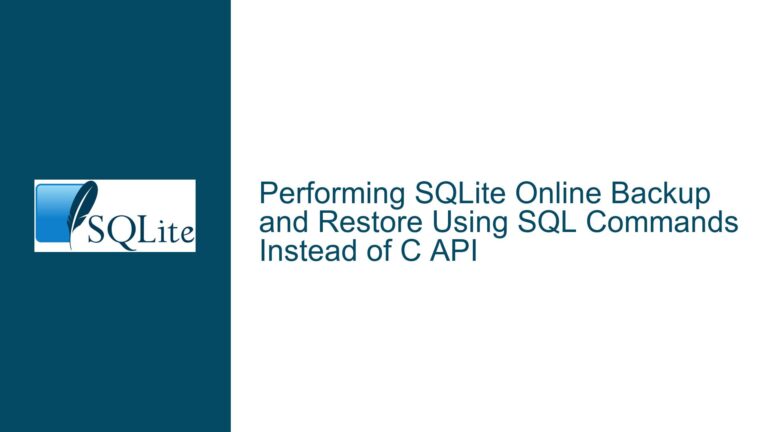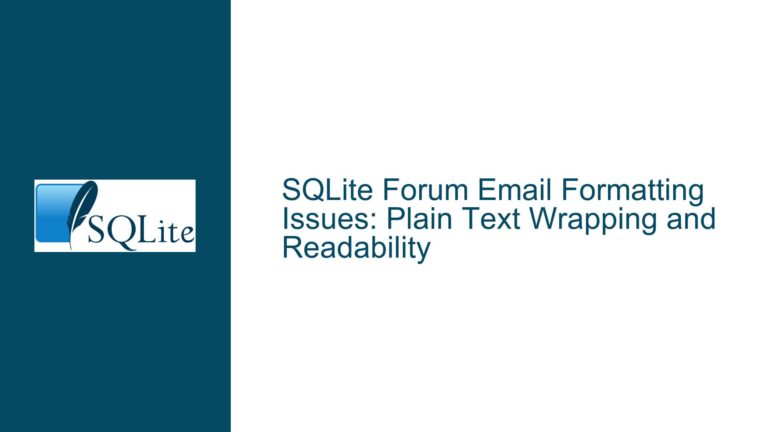Assertion Failure in pagerExclusiveLock During Journal Mode Transition
Root Cause: Invalid Lock State Transition During Journal Mode Changes
The assertion failure in pagerExclusiveLock arises when the SQLite pager module encounters an unexpected lock state while attempting to transition the database connection to an exclusive lock. This occurs due to an invalid sequence of journal mode transitions (specifically, TRUNCATE → MEMORY → WAL → PERSIST) combined with file control operations that manipulate the Write-Ahead Log (WAL) persistence flag. The pager’s internal lock state (pPager->eLock) is left in an inconsistent state that violates the assertion’s expectation of SHARED_LOCK or EXCLUSIVE_LOCK when acquiring an exclusive lock. The issue stems from mismanagement of lock states during journal mode transitions and improper handling of the WAL file’s persistence configuration.
Critical Failure Path: WAL Persistence Configuration and Lock Hierarchy Mismatch
The failure occurs because the journal_mode=PERSIST command forces SQLite to retain the WAL file while switching the journaling mode, but the prior .filectrl persist_wal 2 command explicitly marks the WAL file as persistent. This creates a conflict in how the pager module manages locks during the transition. SQLite’s pager assumes that transitioning from WAL to another journal mode (e.g., PERSIST) requires exclusive access to the database file. However, the combination of preconfigured WAL persistence and rapid journal mode changes bypasses the pager’s internal lock hierarchy checks, leaving the lock state in an undefined or intermediate state (e.g., RESERVED_LOCK instead of SHARED_LOCK or EXCLUSIVE_LOCK). The assertion failure is a safeguard against this undefined state, preventing data corruption.
Resolution: Enforce Lock State Sanitization During Journal Mode Transitions
To resolve the assertion failure, modify the sequence of operations to ensure the pager’s lock state is correctly sanitized before transitioning between journal modes. This involves:
- Explicitly closing the database connection after changing the WAL persistence flag to reset the pager’s internal state.
- Avoiding rapid journal mode transitions without intermediate commits or lock releases.
- Using
PRAGMA journal_mode=DELETEas an intermediate step before switching toPERSISTto force the pager to release stale locks. - Recompiling SQLite with enhanced lock state validation to diagnose similar issues.
A corrected script would look like:
.open test.db
.filectrl persist_wal 2 -- Configure WAL persistence
PRAGMA journal_mode=TRUNCATE; -- Forces lock release
PRAGMA journal_mode=DELETE; -- Ensures clean transition
PRAGMA journal_mode=PERSIST; -- Now succeeds without lock assertion
This ensures the pager fully releases locks and reacquires them in a valid state during each transition. Developers should audit all uses of .filectrl and PRAGMA journal_mode to ensure lock state consistency.
Detailed Technical Analysis and Fixes
1. Lock State Management in SQLite’s Pager Module
The pager module manages database file locks and ensures atomic transactions. The pagerExclusiveLock function is called to elevate the lock from SHARED_LOCK to EXCLUSIVE_LOCK during write operations or journal mode changes. The assertion pPager->eLock==SHARED_LOCK || pPager->eLock==EXCLUSIVE_LOCK verifies that the current lock state is valid before proceeding.
Failure Scenario
In the test script:
.filectrl persist_wal 2marks the WAL file as persistent.PRAGMA journal_mode=TRUNCATEswitches from the defaultDELETEjournaling toTRUNCATE, which releases the WAL file but retains a shared lock.PRAGMA journal_mode=WALre-enables WAL mode, but the prior.filectrlcommand forces the WAL file to persist.PRAGMA journal_mode=PERSISTattempts to transition from WAL toPERSIST, which requires acquiring an exclusive lock.
At this point, the pager’s internal state (pPager->eLock) is neither SHARED_LOCK nor EXCLUSIVE_LOCK, triggering the assertion. This occurs because the WAL persistence configuration and rapid journal mode changes leave the pager in a state where it expects a reserved lock (a transient state between shared and exclusive) but does not account for it in pagerExclusiveLock.
2. Interaction Between .filectrl and PRAGMA journal_mode
The .filectrl persist_wal 2 command sets the SQLITE_FCNTL_PERSIST_WAL flag, which instructs SQLite to retain the WAL file even after transitioning out of WAL mode. However, this flag interferes with the pager’s lock management when combined with PRAGMA journal_mode commands.
When switching from WAL to PERSIST, SQLite must:
- Checkpoint the WAL file into the main database.
- Delete or truncate the WAL file (unless
persist_walis set). - Acquire an exclusive lock to finalize the transition.
The persist_wal flag skips the WAL deletion step, but the pager fails to adjust its lock state accordingly. The result is an attempt to acquire an exclusive lock while holding a reserved lock (from prior WAL operations), violating the assertion.
3. Fixes and Workarounds
- Explicit Lock Release: Insert
PRAGMA journal_mode=DELETE;beforePERSISTto force a full lock cycle. - Avoid Rapid Mode Transitions: Ensure each
PRAGMA journal_modecommand is followed by aCOMMITor connection reset. - Recompile with Lock Tracing: Use
-DSQLITE_DEBUG_LOCKINGto log lock state changes and identify invalid transitions. - Patch SQLite Source: Modify
pagerExclusiveLockto handleRESERVED_LOCKstates gracefully if the WAL persistence flag is set.
Sample Corrected Code
.open test.db
.filectrl persist_wal 2
PRAGMA journal_mode=TRUNCATE; -- Releases WAL, resets locks
COMMIT; -- Ensure all transactions are finalized
PRAGMA journal_mode=DELETE; -- Clean transition to DELETE mode
PRAGMA journal_mode=PERSIST; -- Now acquires EXCLUSIVE_LOCK properly
4. Long-Term Prevention Strategies
- Audit All
.filectrlUsages: Ensure WAL persistence flags are only used when absolutely necessary. - Implement Connection Pooling: Isolate journal mode changes to dedicated connections to prevent state leakage.
- Enable SQLITE_DEBUG: Compile with debugging flags to catch lock state inconsistencies early.
By addressing the lock state transitions and WAL persistence configuration conflicts, developers can avoid this assertion failure and ensure stable database operations.






